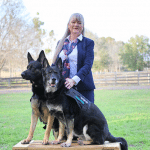When we pair our recipients with their service dogs, we ensure our teams are trained for long-term success. People often think service dogs are forever-trained and will work perfectly for the rest of their lives. In reality, the recipient must remain consistent in the care of their service dog to ensure they retain their skill set and continue to work.
Our Pairing Process
The first step in getting paired with a service dog is filling out and submitting an application. Once we receive your application, a member of our Recipient Relations Department will contact the recipient to go through each item of the application to ensure we understand their disability because we only pair service dogs with those living with a permanent disability, not an illness.
Once the application is reviewed and we’ve confirmed that we fit the recipient’s needs, we can move the process forward. We also require recipients to have a stable lifestyle, meaning that they have lived at the same place for at least six months and have a permanent, stable living situation. The recipient can’t have a lot of other pets in the home as they can cause distraction or damage to the service dog’s ability to perform tasks.
Recipients should also be drug- and alcohol-addiction-free. Before pairing, provide our recipients with the information on how much expendable income they will need to care for the dog monthly. This cost will include their medical insurance program, toys, bed, leash, dog food, and other necessary items for their service dog. Recipients will confirm in writing that they can handle the financial responsibility of a service dog. The service dog is donated, so they are not responsible for the costs that come with training.
Once it is confirmed the recipient meets these criteria, we place them on the waiting list. We begin orientations via video calls, during which we get into the details of being paired and living with a service dog. During these calls, we will involve the recipient’s family and discuss the difference between living with a pet in the home versus a service dog, what is expected of the recipient, and more.
After these orientations via video calls are completed, the dog will be trained to meet the recipient’s unique needs, and we set a pairing date. Recipients must be able to complete the pairing process, which is held over a couple of weeks at our campus.
During this time on campus, the recipients work with our trainers in group and private classes to learn how to care for and work with their service dogs. We will also watch to ensure the pair is bonding properly and that the dog is alerting. These training sessions will also teach the recipient how to recognize and respond to the dog’s alerts, which typically start within the first 24 hours they are working together.
The orientations completed over the video chats are repeated to remind the recipient how to handle and practice with their service dog, how to feed them, etc. Every last detail is covered during their time on campus, and they are provided with a binder that includes everything they have learned. A video library is also offered to help those who prefer to learn that way. This covers all the bases for our recipients and provides them with a wealth of material they can reference if they forget something. Additionally, our trainers are available for recipients to call with any questions or concerns.
How Untraining Can Occur in Service Dogs
A common misconception is that once the dog is trained, they are trained forever. However, this is not true with a service dog or any dog. While our service dogs are expertly and rigorously trained to handle a wide range of tasks to mitigate the challenges of the recipient’s disability, they can be untrained. This untraining can occur when the recipient doesn’t adhere to the guidelines we teach them when paired.
Without practice and consistency, the psychological bond between the recipient and the service dog breaks down, and the recipient is no longer working as 50% of the team. If the recipient becomes complacent, then the dog also becomes complacent.
Suppose the recipient is not maintaining the bond at home and in public. In that case, the dog will find other avenues for mental stimulation, such as becoming distracted by other animals and barking rather than walking politely. Another example is if the recipient begins pulling the leash all the time, it will teach the dog to forge rather than walk with no tension.
The practicing sessions you have with the dog are their reward, where they receive treats and praise. This is like the “paycheck” they get for working. Without consistency and practice, the dog is essentially working without receiving a paycheck, which leads to them finding new ways, aside from assisting and alerting, to get their mental stimulation.
Additionally, the tasks we ask our recipients to complete, such as daily brushing and feeding the dog by hand, are bonding experiences that help keep the bond between the recipient and the service dog strong.
What Happens if I Have an Issue With My Service Dog?
If a recipient has any issues with their service dog, they can contact our trainers for assistance. We are not here to judge our recipients in any way and are happy to assist them with any issues or questions they may have about their service dog.
We can help your recipients get back on track and stay on track as long as they are willing to put in the effort and remain consistent.
Want to Learn More About Service Dogs? Contact us Today!
If you are interested in learning more about how to apply for a service dog, please visit our website today!




